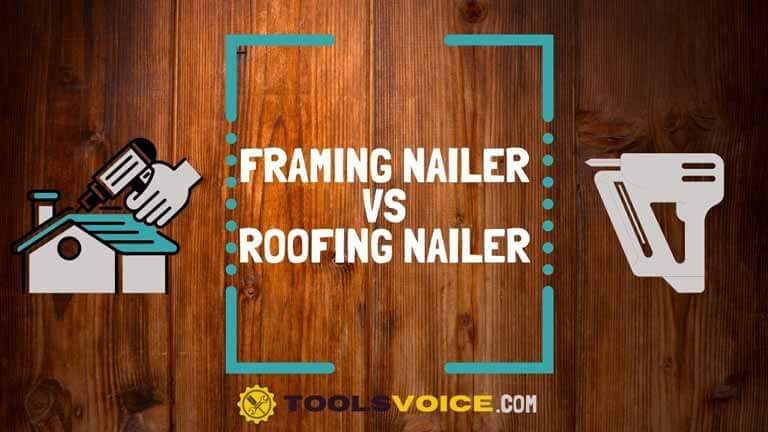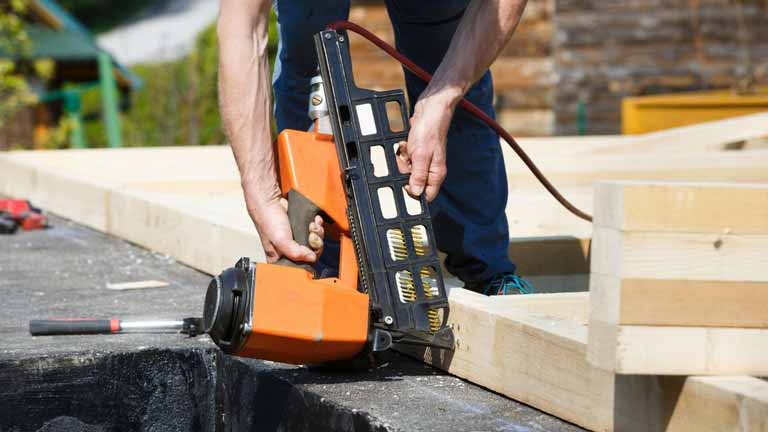Framing nailers and roofing nailers are two different types of tools that can be used for a wide variety of construction jobs. While they can seem very similar in the sense that they both use nails to fasten wood, plastic and other materials together.
But there are some important differences between them that you need to know about before making an informed decision about which tool is best for your needs!

Difference Between Framing and Roofing Nailer
What is Framing Nailer?
A framing nailer is a type of power tool that is used in residential construction, utility work, and other related areas to insert nails. It has a magazine or magazine-style loading, where the nails are pre-set on pins.
The nailer has essentially two parts; the handle that is gripped and the working end, which can be adjusted to different angles. It features an air-powered piston that pierces the metal head through the surface where it can then be shot into the wood.

The framing nail guns come in either coil, straight and angled magazine setups.
Some of its features are an anti-dry fire mechanism to help prevent damage on materials from not being properly lined up for insertion of nails, as well as a depth gauge to help regulate the distance of nails that are being shot into the surface.
What is Roofing Nailer?
A roofing nailer is a type of device that attaches to the end of a nail gun and shoots nails into shingles or other sorts of roofing materials. The roofing nailer has both a horizontal and vertical oriented motion that allows you to install shingles at different angles.
It’s really good for nailing close to the ridge where you can’t get your head and your hands up there. The narrower nose design of the roofing nail gun allows you to use it in those tight spaces.
The nailer will also have a depth gauge and anti-dry fire mechanism, as well as an air release valve that can be adjusted depending on how much pressure is being used in order to suit individual preferences.

If you’re new to roofing, this tool is going to be very handy in getting your roof installed quicker than with a hammer and nails alone.
Roofing nailers are not only used for attaching shingles to roofs; they can also be used for insulation, siding, and other types of construction. They have a larger capacity for loading with more than 50 nails, as well as usually come with a belt clip to make it easy and fast when clipping or unclipping from your body.
Nailer types
Types of Framing Nailer
There are two main types of framing nailers: Cordless framing nailers and Pneumatic framing nailers. They both come with clipped head and round head nail uses models to meet the consumers’ demand. The Clipped head nailers are used for high-volume jobs due to their ability to hold more nails in the magazine.
A pneumatic framing nailer needs an air compressor to operate and requires the use of a long hose to transport compressed air from the tool to the nailer. When framing crews try to dive a nail with the pneumatic framing nailer, air from the hose compresses a piston which then pushes the nail into the wood.
The cordless framing nailer, meanwhile, works much in the same way, but its power comes from a disposable compressed air canister that fits inside of the nailer. This canister combined with a battery drives nails until it needs to be replaced with a fresh one. Check these products for understanding the differences better!
Types of Roofing Nailer
Roofing nailers are also available in two basic variations: pneumatic roofing nailers and cordless roofing nailers.
The pneumatic roofing nailer tends to be faster and lightweight, but it only works with an air compressor that increases the expense and reduces portability.
On the other hand, cordless roofing nail gun takes a couple of seconds to prepare before firing, and their weight is a bit on the higher side that can cause fatigue. But they are highly portable that makes them a top-notch nail gun. Check these products for understanding the differences better!
Nails Uses
The nails framing nailer shoot are quite large and can be used for securing items in place. The size of the nail will depend on the type of wood and the thickness of the wood. Thicker wood requires a longer nail with larger diameter than thinner wood.
The nails typically range in size from two to three and a half inches long, with diameters between .113 and .148 in. Plus, the fastener will have a metal head with a plastic cone or sleeve over it.
Framing nails are used in indoor projects like building furniture or other household items because they can hold better when pulling against tough materials.
The nails roofing nailer shoot are much smaller than their counterparts with an infinitely greater range – this is because roofs have many more angles and various types of surface so it would be difficult (and time-consuming) to use a larger nail.
The nails are usually small, thick, and made of copper or zinc so they will not rust in the roof. Generally, roofing nails are ¾” to 1 ¾” in length with a larger head.
Roofing nails are usually used for outdoor projects like installing siding or fixing shingle damage on your roof.
Safety
Working on a rooftop without safety measures poses an intense risk. The builders must always wear safety helmets, gloves and goggles, as well as use a strategy like tying a rope around their waist for self-protection from falling.
If you want to install solar panels on your roof, always look for high quality at a great price. Otherwise, a roofing nailer will face complications setting them up.
Framing nailers are typically used on the ground, so wearing a helmet isn’t necessary but protective pieces like gloves and goggles should be worn.
When using a pneumatic nail gun, always pay attention to the cord. And if you have a cordless or battery-powered nailer, be careful when using and carrying these models because they are heavier than pneumatic models.
You May Want to Know:
Wrapping Up!
We hope this blog post helps you understand the differences between a framing nail gun and roofing nail gun.
Framing nail guns are mostly used on framing materials but they can also use on sheathing, wood to masonry, fencing and exterior decks. On the other hand, roofing nail guns are only produced best results when used on roofing materials.
Nailing down a roof is one of the most important things you can do for your home. It’s also one of the hardest and most dangerous jobs in the world. That’s why it makes sense to take care when choosing tools that will make this process easier, safer and more efficient.




